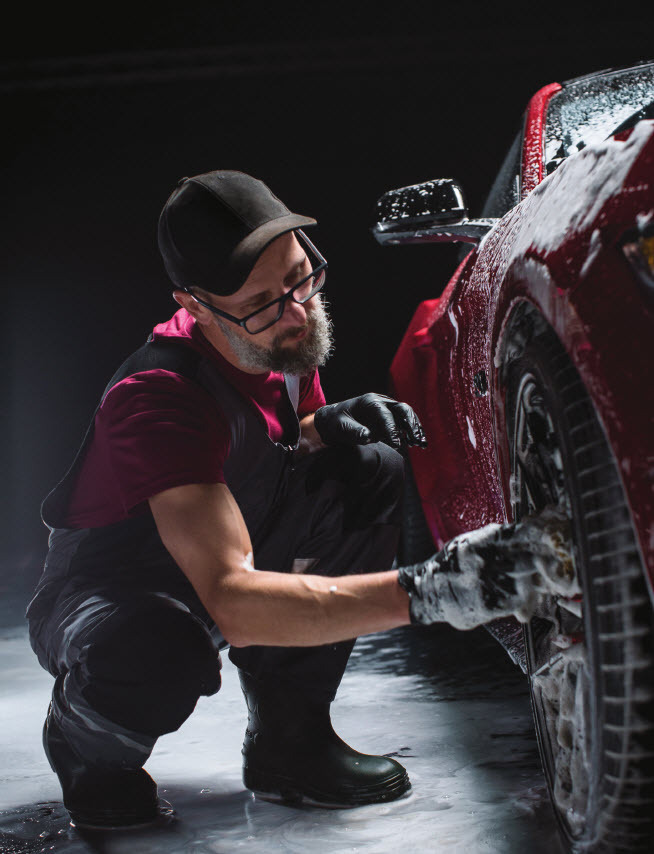
Car Wash Innovation
By Diane Calabrese / Published March 2024

Cars it is. In the everyday lexicon few people refer to them as automobiles or the diminutive autos. From the Latin (carrum or carrus) for a conveyance on two wheels we got to the word car. The word car has persisted and grown in meaning (e.g., rail car).
Yet cars carry not only passengers but universal meaning, and experience with washing a car is quite wide.
For some, the experience is as localized as getting out a bucket of water and a sponge and washing mud off tires or lights—and wishing there were a car wash nearby. Originally, car washes were heavy on manual labor, and their team members tackled cars with suds and sponges.
Over time car washes became more automated with conveyors to move vehicles along a wash, rinse, etc. line. Self-serve car washes entered the picture and so on.
Incremental changes have gone on since the inception of the first car wash. As for the inception, dates range from 1900 to 1946, with many sources (including AAA) converging on 1914. It really depends on how a car wash is defined.
The International Carwash Association (IWA.org) reports on its website that in 2020 it commissioned a third-party, independent study to assess the number of car washes of each type. Tallies reported by type were 17,500 conveyors, 29,000 in bays (roll over), and 16,250 self-serve conveyors.
U.S. Census Bureau data for number of car washes date to 2019. By using the data as a baseline, it suggests modest growth in numbers between 2019 and 2020. But data from the years 2020–2023 remain murky, and as we know many people drove less in that interval.
Despite the global complications of the early years of this decade, innovators did not pause in their efforts to make their sectors as efficient and exacting as possible, and members of the car wash industry are among them.
Doing more with less is exemplified by the changes in the car wash industry. Some of the innovations have been nudged by restrictions on water use and mandates for wastewater recycling. Other changes have been spurred by the difficulties in finding employees. Each innovation allows a process to take place in just a bit better way—a way likely to save some combination of time, energy, money, water, and chemicals—and get even better results.
Simply doing more is in the picture, too. Vacuuming is now a standard part of operations at commercial car washes. Many washes also offer steam cleaning of interiors.
SPATIAL CONSIDERATIONS
Inspiration and necessity both lead to innovations, and on the necessity side, a reality as ordinary as limited space can spark ideas to make layout on a property (a taxable entity in itself) be as conservative as possible.
Thus, when thinking about innovation in the car wash sector, keep in mind the unit cost of space. Profit tied to each unit of space generally grows with each innovation. Moreover, conserve space and reduce the cost of operation.
Noteworthy recent innovations? “Two things come to mind,” says Kraig Snyder, the national sales and marketing manager at J.E. Adams Industries, Ltd., in Cedar Rapids, IA.
One is “installing vacuum/arch systems that have a tool on both sides of the car,” says Snyder. He notes the arrangement “allows two people to vacuum one car simultaneously, cutting the amount of time required to vacuum the entire interior without using any additional energy.”
And the second is “using polemounted vacuums instead of a central vacuum producer,” says Snyder. “This allows the site to power the vacuums on an ‘as-needed’ basis. When customers pull into the site, they activate the vacuum for their stall rather than having a big producer running the entire time the car wash is open.”

Innovators have also been working to keep pace with societal changes that have affected all businesses, including car washes. “Trying to stay on top of all the ‘cashless’ payment systems from a technology standpoint, as well as the available real estate on the front of a vacuum or payment station, can be a real challenge,” says Snyder.
“A machine or carwash box, which was originally designed for a coin [mechanism] or bill validator only, has its limits when you start to add credit-card swipes, chip readers, and/or tap units,” explains Snyder. Embracing the multiple methods of exchange requires adjustments.
“In some cases the embrace requires multiple pieces of equipment,” says Snyder. “There are also QR readers, barcode scanners, keypads, and additional displays—all of which require additional space. It will help as cashless equipment companies come to market with multi-function units that can handle multiple forms of these payments.”
CHEMICAL ASSISTS
Design changes are integral to mechanical innovation. The optimal configuration of a car wash also benefits from developments in chemicals.
“Chemical product selection plays a critical role in efficiency in the car wash environment,” says Joseph Daniel, CEO of ITD Inc. in Tucker, GA. “Two-step chemical systems—alkaline plus acid steps—enable a touchless process, which reduces energy usage and removes wear parts such as brushes and mops.”
Being able to jettison brushes and mops that must be replaced by the precise use of chemicals offers a cost saving to be sure. There’s efficiency there.
The short of it is to think carefully about chemicals. The possibilities chemicals offer for improving outcomes or speeding along excellent outcomes exist throughout the car wash process.
“Selection of a quality pre-soak chemical can remove the front-end employees commonly used to mechanically remove bugs,” says Daniel. “Use of a quality rinse aid chemical on the back end reduces the amount of air required to dry the car, and thus reduces energy usage.”
But the results can be even more dramatic. “A modern car wash can largely be run in automatic fashion without employees, if a proper chemical program is in place,” explains Daniel.
From the Bay State to the Golden State, environmental regulators take an ever-keener interest in vehicle washing (and maintenance). Scrupulous management of wastewater— and recycling/reuse to the extent possible—is the highest priority.
Of course, states like Massachusetts and California lead the way on environmental regulations. Solvents, antifreeze, brake fluid, battery acid, motor oils, fuels, and lubricating grease may wash off a car during washing (or maintenance). Proper handling of the castoff materials must be part of the activity at a car wash.
Some car wash businesses contract with car dealerships. As such, cars that have undergone routine vehicle maintenance may arrive for a wash, which adds to the likelihood of solvents, fluids, etc. released during maintenance being in the wastewater.
360° VIEW
Chain rollers have been supplanted by conveyors. Car washes have changed, and they continue to improve.
Innovation comes from every direction. Steam cleaning exteriors has long been a tool of auto detailers, but steam has been deemed by many as a viable match for coatings—doing an excellent job and doing it with no damage. Expect to see more of it because of the savings in water.
The basic tools of car washes keep getting better. While many experts continue to prefer the gentleness of a chamois/chammy, others have been persuaded that synthetics made of microfibers are equally good or better.
CRM [customer relationship management] and POS [point of service] tools have been adopted by many car washes. Whether helping clients keep track of their last wash and wax and reminding them to get another, or conveying the options that might go along with a wash (e.g., wax), the tools help to boost business in some regions.
Subscription plans are also popular in some parts of the country. Washes that offer subscriptions can depend on a steady revenue stream over a set period of time. But if costs rise faster than expected, plans may take a toll on a business.
In some parts of the country, CRM and subscriptions might not be worth the investment. There is a pool of customers that simply want a good, quick wash when needed. Indeed, where permitting rules are sufficiently flexible, self-serve washes are still available and often tied to a convenience store or a gas station. Just as with any business, a car wash must know its market.
Whether the choice is a basic wash or one with add-ons, almost every customer wants one thing: speed. Car washes must be able to gauge and accommodate the flow of customers. In certain urban areas, the jams that occur at the entrances to car washes cause some would-be customers to get out of line and skip the wash. (CRM systems can help prevent bottlenecks by encouraging customers to arrive or schedule washes when they can enter, get clean, and exit without a wait.)
About that “clean” outcome: Tying a clean car to safety is not a genuine innovation. Yet the link could be more widely used to remind drivers that windshields and lights especially should be clean for safety. Tires should never be so soiled that the dirt or debris on them has under-tread skid potential.
Clean and safe and convenient: cars.





